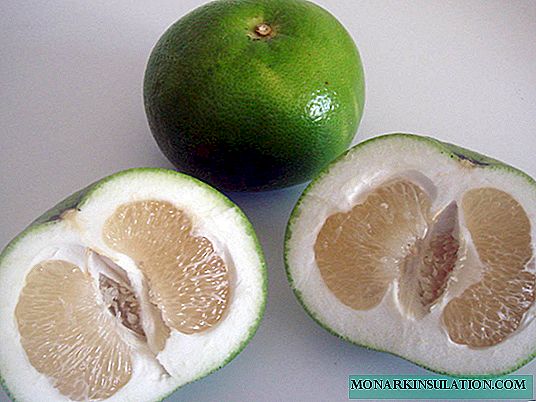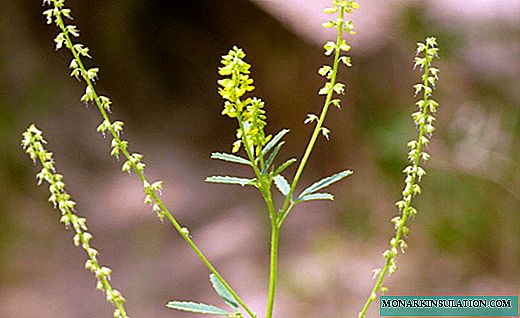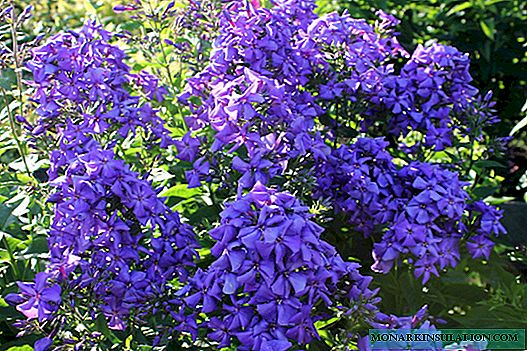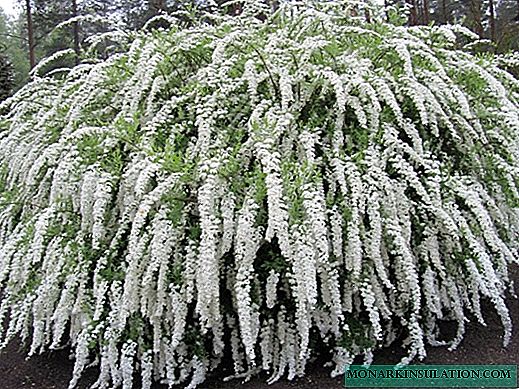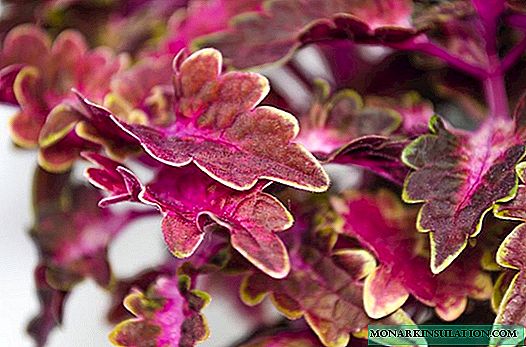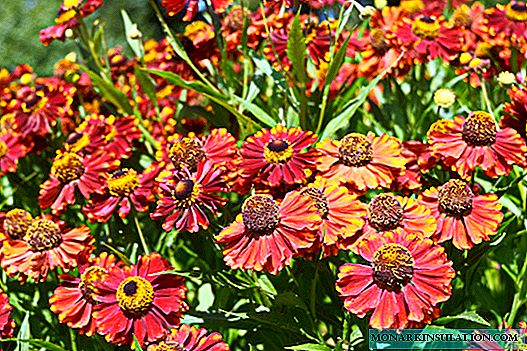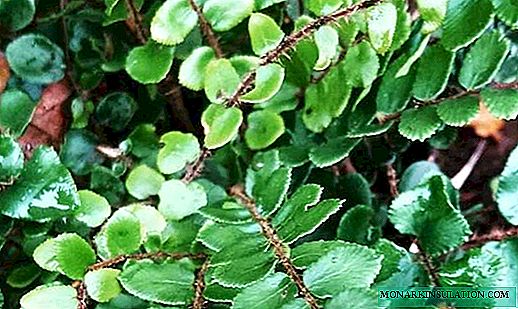A variety of garden flowers allows you to choose the most suitable for the design of the site. Recently, the buzulnik has gained popularity. This is a perennial plant with lush foliage and bright flowers. There are many varieties of this flower, but the most popular is the group, united by the name Buzulnik Przhevalsky.
Description of Buzulnik Przhevalsky
Buzulnik is a perennial herb, belongs to the Astrov family. Due to the shape of the marginal flowers, the second name is ligularia. There are many varieties of this plant.
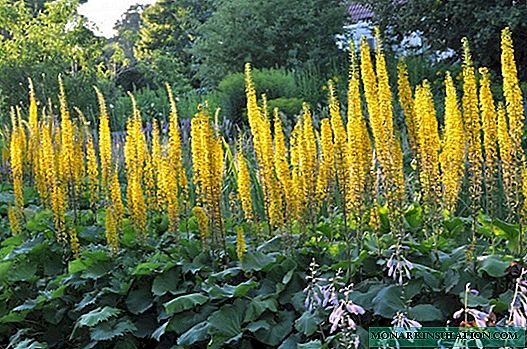
Buzulnik Przhevalsky named after the Russian traveler
Buzulnik Przhevalsky (ligularia przewalskii) got its name in honor of the Russian naturalist and traveler Nikolai Przhevalsky. In addition to Central Russia, the flower can often be found in the Urals, however, the plant is most common in some areas of China. In this country, it is used as a medicine - antibacterial substances are present in its root system.
The flower is tall and can reach a height of 1.8 meters. The leaves are dissected, very openwork with sharp edges, located on the petioles of a red-brown hue. Buzulnik Przhevalsky differs in inflorescences - they are collected in spikelets and can reach 70 cm in height, while the tops of them can be slightly saggy.
The variety belongs to the early ones. The flowering period begins at the end of June, ends about a month later - at the end of July, after which seed formation occurs.
Attention! The plant loves shaded and moist areas, grows well near ponds.

The culture grows quite high, is decorative
Planting a plant
Planting is carried out using seeds. However, it is worth remembering that a culture grown in this way will bloom only after 3-4 years. The method itself is quite time-consuming, it takes time and attention.
Seed planting
First of all, prepare the soil in a separate place. In autumn - November, December - the seeds are sown in soil to a depth of about 2 centimeters. In this case, they will undergo a natural stratification.
In the spring, when the snow melts, seedlings will begin to appear. When they get a little stronger, you can transplant them to a permanent place.
Planting seedlings in open ground
Buzulnik can also be planted with seedlings. At home, seeds begin to sow in March. Fertile soil is poured into the container, seeds are laid out to a depth of not more than 1 centimeter. The pot is covered with a film or glass.
Constantly maintain soil moisture and moderate temperature. When shoots appear, the shelter is removed and continued to care for them. Gradually, the sprouts will grow and they can be transplanted into separate pots.
Attention! Planting seedlings on the street should be after the threat of repeated frost passes.

Inflorescences are spikelets
How to care for the Przewalski Buzulnik
Buzulnik Przhevalsky is an unpretentious plant, which even a beginner will cope with. However, some care features still need to be observed.
Watering
The plant loves moist and nutritious soils. It will grow well next to ponds and in the shade of large trees. In this case, irrigation will be needed only in a very dry time. If the flower grows on drier soil, then watering should be carried out regularly. To preserve the necessary moisture, mulch in the form of chips or straw is allowed.
Permanent irrigation is carried out before the onset of autumn days, after which the frequency is reduced by half to avoid decay of the root system. In addition, this species of buzulnik also does not like to be in constant moisture, so it is not recommended to be too zealous.
On dry days, spraying the plant with warm water is allowed. The procedure is carried out in the morning or in the evening, in order to prevent direct sunlight from falling on the foliage and to avoid burns.
Attention! A variety of Przhevalsky does not like to be in the sun, so open areas will not suit him - the plant will wither and may die.
Top dressing
Buzulnik Przhevalsky, like any other cultivated plant, perfectly perceives various top dressings. They can be organic and mineral. The first time fertilizer is applied during planting, it is recommended to use mineral fertilizers that are most suitable for this type of soil. Humus is introduced every year.
In the spring (in May) the culture is fertilized with a solution of cow manure. Mixed with water in a ratio of 1/10. One bush will require up to 4 liters of the finished solution, watered under the root.

Buzulnik Przhevalsky will give any area of decorativeness
Pruning
Buzulnik Przhevalsky does not require trimming. Remove old and dried leaf blades, branches. If reproduction by self-seeding is not planned, then immediately after flowering, it is necessary to cut off the inflorescences. In this case, the appearance of seeds will not occur. In addition, nutrients begin to be distributed over the leaves and shoots, and do not go away only in inflorescences.
Pruning is also carried out before preparation for the winter period. The branches are cut very low, then sprinkle the bush with leaves, mulch with humus. If desired, you can cover the plant with special material, although the culture is quite normal in winter frosts.
For reference! Planting and caring for the Przewalski Buzulnik does not require special forces and a lot of time. Even an inexperienced person can handle such a culture.
Breeding methods
Reproduction of the Przewalski Buzulnik is carried out in two ways - by seeds and division of the bush.
In order to get seeds, at the end of flowering, fabric bags are left on good inflorescences, tightly tied them. After some time, they are cut from the branches, the seeds are peeled and dried well.
In autumn, the seeds are poured into the ground, where they are all winter, and in the spring they begin to germinate. Further, everything is done in the manner described above.
Division of the bush allows you to get immediately a large plant, which, moreover, will begin to bloom earlier than those that have grown from seeds.
- Rhizome is cleaned from the ground, washed.
- They are neatly divided into several parts with the condition that each of them has an active kidney.
- Sections must be disinfected or sprinkled with charcoal.
- Before planting, it is required to prepare holes 40 * 40 in size, in which humus and fertile soil are poured on the bottom.
- New sprouts are carefully placed in them, they fill up the earth and well watered.

After flowering, seeds appear instead of flowers
Transfer
Buzulnik Przhevalsky is a perennial plant. In one place, it can be up to 20 years. However, experienced gardeners recommend rejuvenating it by dividing every 5 years.
If necessary, the bush can be transplanted to another place. To do this, first prepare a hole suitable for the root system. Pour fertile soil and humus into it.
The flower itself is carefully transferred to a new place with a lump of earth. Add the required amount of soil, slightly compact it. The plant is well watered.
For reference! It is best to carry out such actions in spring or early autumn, so that the culture has managed to adapt to new conditions before winter.
Diseases and Pests
Przewalski Buzulniki are practically not exposed to diseases and are not affected by pests. The most common disease is powdery mildew, which can develop due to high humidity. If signs are found, it is recommended to use fungicidal preparations and treat the entire plant. In addition, it is necessary to normalize watering.
Due to the constant humidity, slugs may appear on the site, which also damage the flower. They eat leaves and branches, after which the plant loses its decorative appearance and may even die. You can deal with the problem in both folk and chemical ways using specialized drugs.
Snails do the same harm as slugs. The methods of dealing with them are similar.
Flowering period
Przewalski's Buzulniki bloom in June-July. Inflorescences are, most often, spikelets of small flowers. However, for example, in the Palmatiloba Buzulnik variety, spikelets of inflorescences are quite large and noticeable.
Shoots with wilted panicles are removed if they do not want seeds to form. During the flowering period, a pleasant aroma appears, which can be carried several meters from the flower bed.

The plant is very fond of landscape designers for its decorative appearance and unpretentiousness
Winter preparations
The branches are cut very low, then sprinkle the bush with leaves, mulch with humus. If desired, you can cover the plant with special material, although the culture is quite normal in winter frosts.
Use in landscape design
Przewalski's Buzulnik is often used for landscape design. The bushes of the plant are quite powerful, the leaves are distinguished by openwork, the flowers are bright and attract attention. Plants are commonly used to decorate ponds, recreation areas. The culture is well suited for flower beds and flower beds.
The flower grows well alone, but in the company of other plants it has a decorative appearance, for which we are loved by many designers. It goes well with plants with blue flowers. In addition, the buzulnik is very unpretentious and is perennial, therefore it allows you to create designs that retain their attractiveness for a long time.
Buzulnik Przhevalsky is one of the many varieties of this plant. Perfect for areas with moist soil, grows well in the shade, does not like the constant sun. The culture does not require special care, it is rarely sick and practically is not damaged by pests, so even a beginner grower can grow it.

